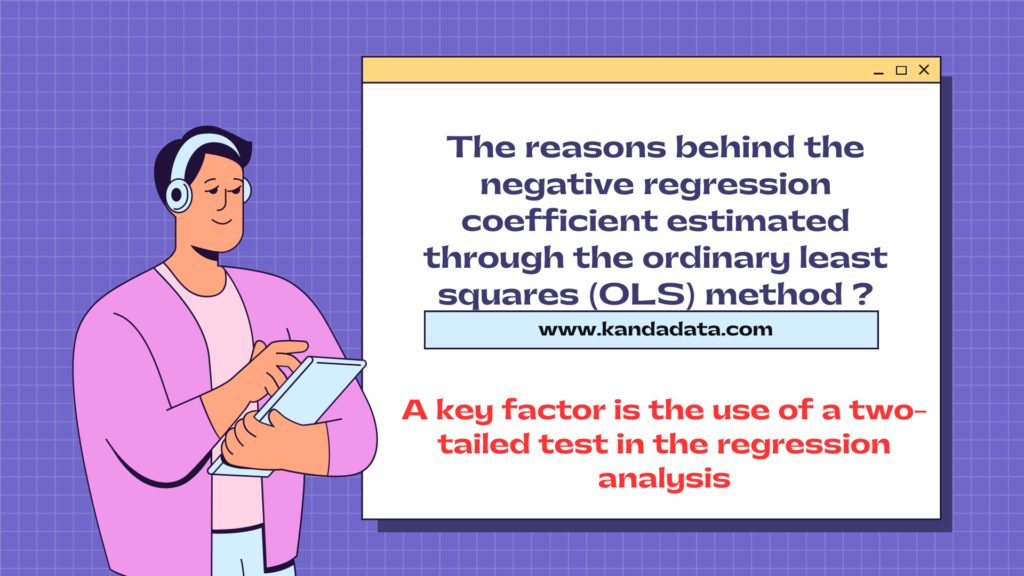Blog
How to Interpret Negative Coefficient Estimations in Linear Regression?
The ordinary least squares (OLS) method is commonly employed in linear regression analysis to establish the relationship between the independent and dependent variables. Despite its numerous advantages, researchers must meet certain requirements to use this method.
Specifically, researchers must test the necessary assumptions to ensure that the estimation results are not biased and are consistent, which is referred to as the best linear unbiased estimator (BLUE).
When analyzing data using linear regression with the OLS method, researchers must accurately interpret the essential components of the analysis results. As such, it is crucial to comprehend how to interpret the output of linear regression.
A common question that arises among researchers and final-year students during research is why a negative regression estimation coefficient occurs. To address this query, this review will examine the potential reasons for the estimated negative linear regression coefficient.
Understanding the T-Statistic in Linear Regression Analysis
In both simple and multiple linear regression analyses, researchers must possess a good understanding of t-statistics, as it is a critical value used in statistical hypothesis testing. The testing involves evaluating whether to accept or reject the null hypothesis, and t-statistics plays a significant role in the decision-making process.

There are two criteria used in statistical hypothesis testing: the first compares the t-statistics value to the t table, while the second examines the alpha probability value. When conducting statistical hypothesis testing, a t-statistics value greater than the t table value leads to the rejection of the null hypothesis.
Conversely, if the t-statistics value is less than the t table value, then the null hypothesis is accepted. Additionally, if the p-value is less than or equal to 0.05, the null hypothesis is rejected, while if the p-value is greater than 0.05, the null hypothesis is accepted.
Negative T-statistics
Researchers often encounter challenges when comparing the t-statistics value with the t table value. This is because the values in the t table are typically positive, whereas the t-statistics value may be negative, especially if the estimated regression coefficient is negative. In such instances, researchers may doubt the accuracy of the data collected.
Before comparing the t-statistics value with the t table, it is crucial to understand the difference between two-tailed and one-tailed tests in hypothesis testing. Two-tailed tests are often used in studies that use the OLS regression method, whereas one-tailed tests determine whether the direction is positive or negative. With a two-tailed test, the estimated regression coefficients may be either positive or negative.
Cause of Negative Value of Regression Estimated Coefficient
In relation to the topic at hand, the current discussion explores the reasons behind the negative regression coefficient estimated through the ordinary least squares (OLS) method. A key factor that contributes to this phenomenon is the use of a two-tailed test in the regression analysis.

Consequently, when examining t-statistics and t-table, it is sufficient to compare the values, as the negative sign reflects the direction of influence. For instance, when studying the impact of price on the quantity demanded of a product, a researcher may utilize simple linear regression analysis and observe a negative estimated regression coefficient, such as -0.85.
This result indicates that an increase in price is estimated to decrease the quantity demanded, while a decrease in price is estimated to increase demand. This interpretation aligns with the established theory, as evidenced by a p-value lower than 0.05 (assuming an alpha level of 5%). Furthermore, the researcher has conducted a significant test by comparing the t-statistics with the t-table values.
No need to worry if the estimated regression coefficient is negative

Researchers need not be concerned if they obtain a negative estimated regression coefficient. Instead, they should focus on the magnitude of the t-statistics value, with values above 2.5 indicating rejection of the null hypothesis and acceptance of the alternative hypothesis that the independent variable has a significant effect on the dependent variable.
When using statistical software for analysis, comparing the t-statistics value with the t table is unnecessary. Instead, researchers should examine the p-value or Sig, and set the alpha level at 1%, 5%, or 10%, before comparing it with the p-value.
If the p-value is smaller than the specified alpha level, it indicates rejection of the null hypothesis or acceptance of the alternative hypothesis, and concludes that there is a significant independent variable effect on the dependent variable under investigation. If there are any further questions or discussion points, you are welcome to leave a comment below, and the article will be updated accordingly.
